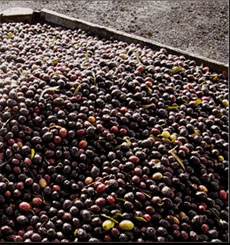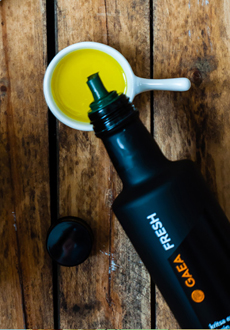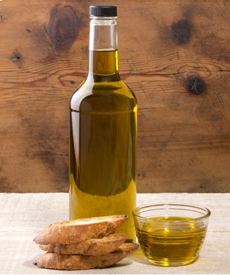|
Some 10 years ago, the Food and Drug Administration allowed a qualified health claim on food labels of olive oil. The claim states that daily consumption of 2 tablespoons, or 23 grams of olive oil, may reduce the risk of coronary heart disease. The decision to allow the claim was made after the FDA found sufficient evidence to conclude that monounsaturated fatty acids, naturally present in olive oil, may prevent heart disease.
This spurred the consumption of olive oil in the U.S. So if your healthier eating plans for the new year include those two tablespoons, here are tips for buying olive oil from an expert: David Neuman, CEO of Gaea US and a certified master panel taster trained at ONAOO, the Organizzazione Nazionale Assaggiatori Olio di Oliva (National Organization For The Tasters Of Olive Oil).
While American olive oils tend to be well monitored, that’s not so with some imports. The industry has long been fraught with fake and doctored oils, fooling even good retailers.
For your money and your heart-healthiness, here are some tips to help you find the real deal.
TIPS TO BUYING QUALITY EXTRA VIRGIN OLIVE OIL
1. Look & Taste
Color is not necessarily an indicator of quality. The color has a lot to do with the variety of olive being crushed, the stage of the harvest the olives were picked and the time and temperature of the malaxation† process. And if the oil is filtered or not. Not to mention, many olive oils are sold in dark glass bottles which help preserve the oil, but make it impossible to see the color before you buy.
Neuman prefers robust oils of a premium nature that are early harvested and quickly malaxed using olives that are prone to being more green. However, he says, there are wonderful oils such as from Sicily that are yellow and have a very intense fruity taste accented by bitterness and pungency. They are of excellent quality, but not dark green in color.
There are also different styles, which appeal to different plates. Some examples:
Fruity, a factor affected by variety, maturity, processing and growing conditions.
Bitter, a feature of good, young olive oil, the intensity of which depends on the olive variety and ripeness, as well as on the milling technique.
Pungent (chemesthesis), throat-catching and/or mouth-hot, a characteristic of Tuscan olive oils.
2. Aroma
Neuman thinks that a much more precise indicator of the quality of an olive oil is the aroma. A quality EVOO should taste fresh, green, peppery and grassy.
While you first have to purchase the bottle, Neuman recommends the sniff test, which is also the way to judge how an opened bottle of olive oil is holding up.
When you open the bottle it should smell green and grassy, or even ripe and tropical (depending on variety, ripeness, milling, etc. etc. etc.). It should smell good.
Look out for fustiness or rancidity, two common defects in olive oil. If you are reminded of a gym locker, sweaty socks, stinky football pads, feet, cheese, crayons, old peanuts, or a compost heap that is too wet, that oil has not been made with fresh, healthy olives. Return it to the retailer!
Rancidity doesn’t show up in the aroma until it’s fairly advanced, but you will can smell it immediately and taste it as soon as the oil is in your mouth: It will have a greasy, fatty mouthfeel. If you get an impression of crayons, wax, window putty, old linseed oil or oil paint, rancid walnuts or peanuts, “cat piss” or a wet compost heap: That’s rancidity.
Here’s more on the flavors and aromas of olive oil.
_________________________________
*Olive oil should be used to replace, and not add to, the other fats present in your diet. Here’s more on the recommendations.
†Malaxation is the churning or mixing of milled olives for 20 to 40 minutes. This allows the smaller droplets of oil released by the milling process to aggregate and be more easily separated. Here’s more about malaxation.
|
|




The color of olive oil is based on various factors, and is not necessarily indicative of quality. Top: Just-harvested olives at O Olive Oil. Second: A green-hued olive oil from DeMedici. Third: A yellow-hued premium olive oil from Gaea. Bottom: If you butter your bread, switch to an olive oil dipper. You can add herbs, chili flakes, or enjoy it plain, like this Coratina olive oil from Murrays.com.
|
3. Price
Price typically is a solid indicator of quality. The more the oil costs, the better the quality. But there’s a catch: A high-priced oil can sit on the shelves for years and be completely rancid. Check for “best before” dates, or at least harvest dates. You can check online for the shelf life of the particular oil.
Bottle dating is voluntary, and this type of transparency is not yet universal on bottles from all producers in countries. But you can let it be a deciding factor in your purchase.
Watch out for bargains. If the price is so low and seems too good to be true, it probably is. Expect to spend more than $10 for a 17-ounce bottle of EVOO.
Look for extra virgin olive oils that are from a single source. This can range from a single estate to a single Protected Designation of Origin (PDO—these regional designations are policed well by the EU) to a particular region or country.
The worst sign is a label that says, “May contain olive oils from Spain, Italy, Greece, Tunisia, Turkey, Argentina and Australia” (i.e., more than one country) or “Mediterranean blend.” This means that the oil is from an industrial packer that sells bulk not quality, and not a conscientious olive oil producer.
FINAL TIPS
Beware of “extra light” olive oil. Neuman warns that an “extra light” label does not indicate an olive oil that is light in calories. Rather, it is a refined olive oil blend, made with olive oil that has been heavily refined so that it has no color, aroma or flavor. It is blended with about 10% Extra Virgin or Virgin grade for flavor and color, and is the lowest-quality olive oil sold to consumers. Avoid it!
Study up before you buy. Check out our Olive Oil Glossary, what you need to know about extra virgin olive oil, and how to taste olive oil.
Olive oil sensory wheel: How to learn the flavors and aromas of olive oil.
|



